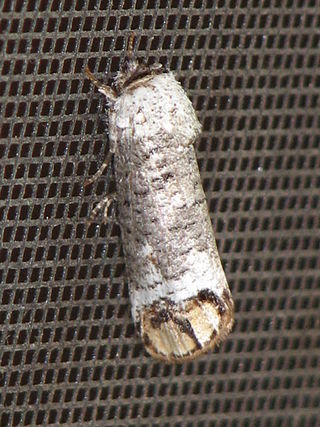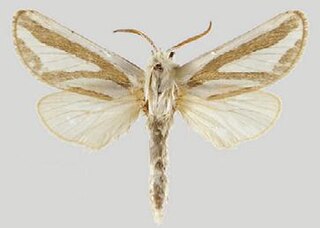
The Cossidae, the cossid millers or carpenter millers, make up a family of mostly large miller moths. This family contains over 110 genera with almost 700 known species, and many more species await description. Carpenter millers are nocturnal Lepidoptera found worldwide, except the Southeast Asian subfamily Ratardinae, which is mostly active during the day.

Hippotion celerio, the vine hawk-moth or silver-striped hawk-moth, is a moth of the family Sphingidae. It was described by Carl Linnaeus in his 1758 10th edition of Systema Naturae.

Phragmataecia castaneae, the reed leopard or giant borer, is a moth of the family Cossidae. It was described by Jacob Hübner in 1790. It is found in central and southern Europe, the Middle East, the Caucasus, Transcaucasia, Turkmenistan, Kazakhstan, north-western Iran, Iraq, Syria, Sri Lanka, Madagascar, India, Lebanon, Turkey, western China, south-western Siberia, Egypt, Tunisia and Morocco.
Dactyloplusia is a monotypic moth genus of the family Noctuidae erected by Chou Io and Lu Chinsheng in 1979. Its single species, Dactyloplusia impulsa, was first described by Francis Walker in 1865. It is found in Sri Lanka, India, southern China, Sundaland, Sulawesi, New Guinea, Fiji and Australia.

Aporandria is a monotypic moth genus in the family Geometridae described by Warren in 1894. Its single species, Aporandria specularia, was first described by Achille Guenée in 1857. It is found in Sri Lanka, India, Vietnam, Thailand, the Andamans, Peninsular Malaysia, Sumatra, Borneo, the Philippines and Sulawesi.

Eudocima materna, the dot-underwing moth, is a moth of the family Erebidae found in widespread parts of the world, mainly in tropical Asia extending to New Guinea and Australia as well as in Africa. Reports from the United States, Canada and the French Antilles are now considered to be Eudocima apta. The species can be differentiated from other Eudocima moths by the presence of small central black dot in each hindwing. The species was first described by Carl Linnaeus in his 1767 12th edition of Systema Naturae.

Mythimna decisissima is a moth of the family Noctuidae first described by Francis Walker in 1856. It is found from India across south-east Asia including Hong Kong, Japan, Taiwan and Australia in Queensland and New South Wales. It is also present in South Africa.

Xyleutes persona is a moth of the family Cossidae. It is found in the Indian subregion, Sri Lanka, south-east Asia, Sundaland, Sulawesi, New Guinea and Queensland. The habitat consists of lowland forests.

Meharia is a genus of moths belonging to the family Cossidae.

Aethalopteryx is a genus of moths belonging to the family Cossidae.

Azygophleps is a genus of moths belonging to the family Cossidae.

Mormogystia brandstetteri is a moth in the family Cossidae. It is endemic to the Socotra Archipelago, part of Yemen in the Indian Ocean.

Mormogystia proleuca is a moth in the family Cossidae. It is found in the southern part of the Arabian peninsula, including southern Saudi Arabia, southern Oman (Dhofar) and Yemen.

Mormogystia reibellii is a moth in the family Cossidae. It is found in North Africa and the northern part of the Arabian Peninsula, including the northern part of Saudi Arabia, northern Oman, the United Arab Emirates, Israel, Egypt, Algeria, Libya, Tunisia, Mauritania, Niger and Chad.

Mormogystia equatorialis is a moth in the family Cossidae. It is found in Kenya.

Arctornis cygna is a moth of the family Erebidae. It is found in Bengal, Sikkim, China, Taiwan Sri Lanka and Thailand.

Polyphagozerra coffeae, the red coffee borer or coffee carpenter, is a moth of the family Cossidae. It was described by John Nietner in 1861 and is found in Asia. Records from the Moluccas and New Guinea refer to Polyphagozerra reticulata, which was previously considered to be a synonym of P. coffeae. It is a widespread pest that attacks many plants.

Wiltshirocossus aries is a species of moth of the family Cossidae. It is found in southern Spain, on the Canary Islands, as well as in Mauritania, Israel, Saudi Arabia, Bahrain, the United Arab Emirates, Yemen, Oman, Algeria, Tunisia and Egypt. The habitat consists of deserts and semidesert areas.

Xyleutes is a genus of moths belonging to the family Cossidae and typical of the tribe Xyleutini.

Duomitus is a monotypic moth genus in the family Cossidae described by Arthur Gardiner Butler in 1880. Its only species, Duomitus ceramicus, described by Francis Walker in 1865, is found in Yunnan in China and from southern India and Malaysia to Sumatra, Ceram and New Guinea.

















